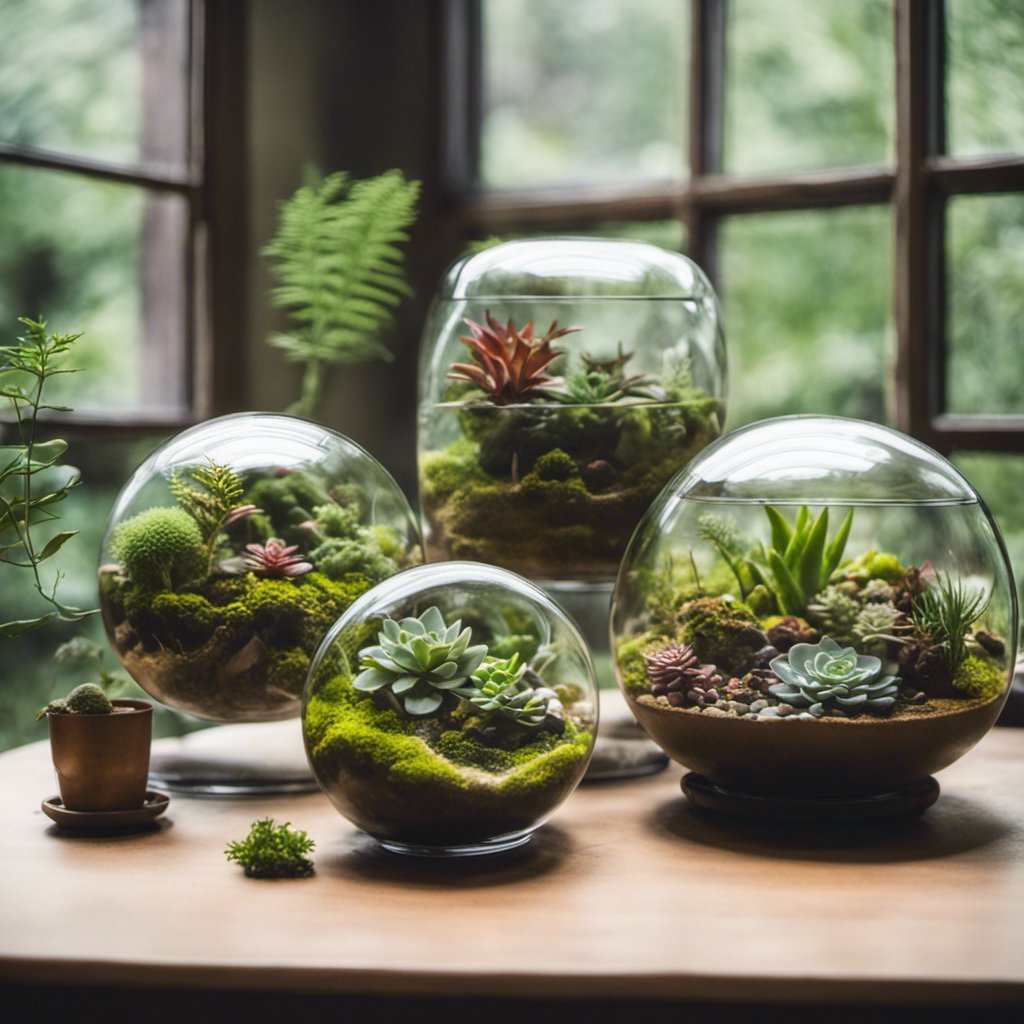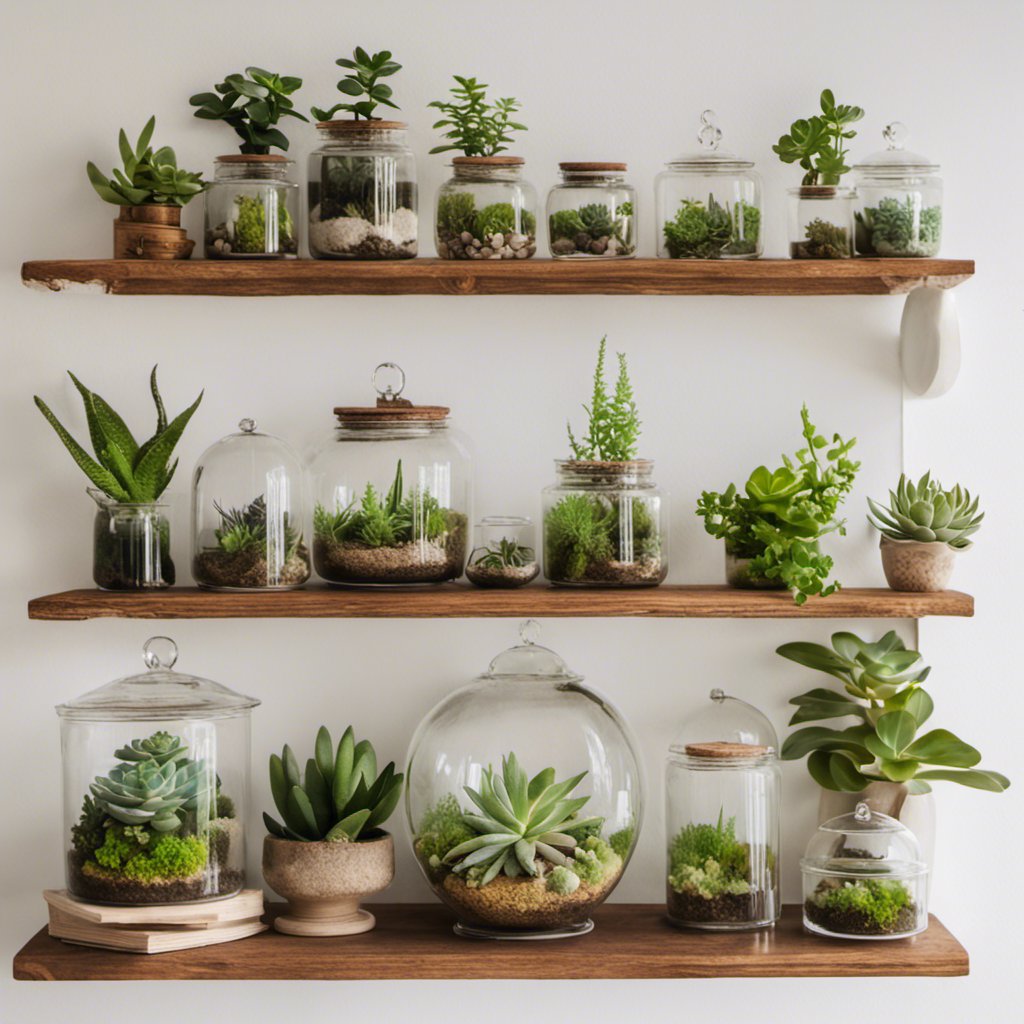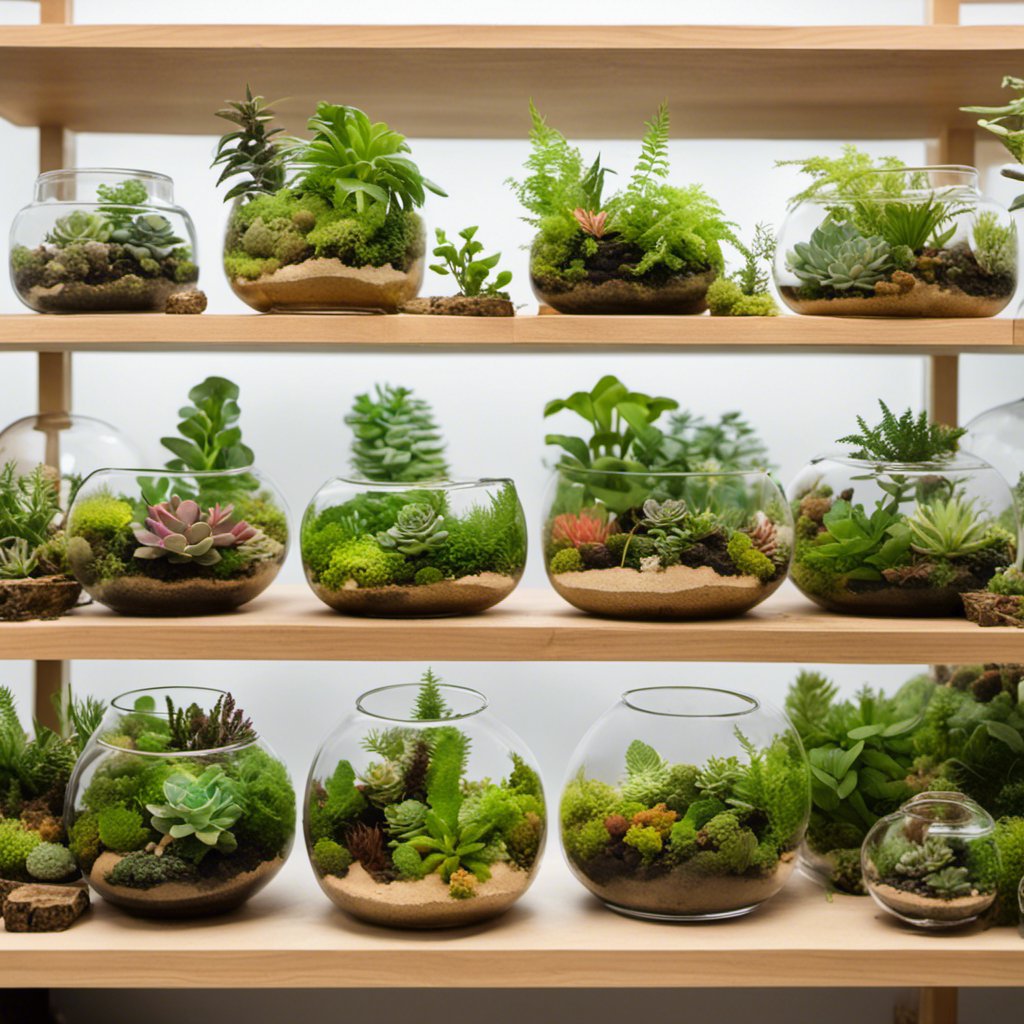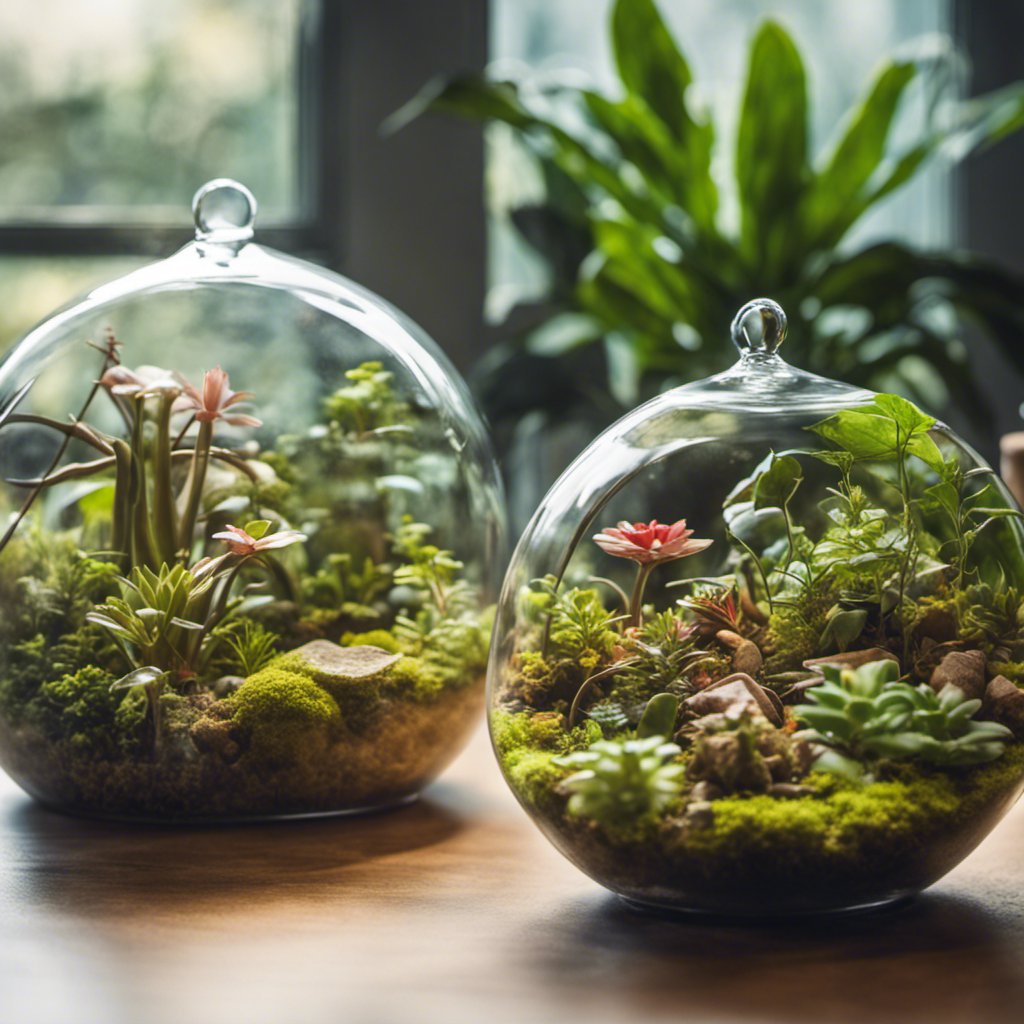Terrariums possess an enigmatic allure, beckoning individuals into the realm of mesmerizing miniature ecosystems where plants flourish. These captivating glass enclosures fashion a controlled ambiance that nurtures and sustains plant life, even within confined spaces. The encapsulated nature of terrariums ensures the optimization of vital elements such as temperature, humidity, and moisture levels, granting plants the opportunity to thrive with minimal intervention.
A pivotal facet of terrariums lies in their capacity to spawn harmonious ecosystems conducive to plant growth. The interplay between sunlight seeping through the glass walls and the trapped moisture engenders an idyllic milieu for photosynthesis to unfold its magic. Through this innate process, plants harness light energy and convert it into chemical energy—a catalyst for robust growth and development. Moreover, hermetically sealed systems curtail water loss via evaporation, thus bestowing upon plants unwavering hydration.
Terrariums also confer a distinct advantage by safeguarding flora against environmental adversities. By enclosing them within glass confines, these sanctuaries shield delicate species from inclement weather conditions or invasive pests that may pose harm. This protective barrier simultaneously mitigates exposure to external pollutants or diseases—preserving plant health while preventing potential devastation.
Key Takeaways:
| Aspect | Key Points | Benefits | Examples/Notes |
|---|---|---|---|
| Environment & Growth | Optimal conditions for plant growth | Plants thrive in controlled temperature, humidity, and light. | Protects against temperature fluctuations, pests, and diseases. |
| Protection | Shields plants from stressors | Protects against temperature fluctuations, pests, diseases. | Acts as insulating barriers, physical barriers against pests. |
| Space & Design | Suited for limited space gardening | Ideal for urban dwellers or confined spaces. | Reduces risk of disease, and ensures long-term survival. |
| Health & Disease Prevention | Maintains plant health | Suited for limited-space gardening | Can be custom-designed, and versatile in design options. |
| Aesthetic & Decorative Value | Enhances indoor spaces | Infuses spaces with natural beauty and tranquility. | Regulates humidity, and improves airflow. |
| Educational Value | Offers hands-on learning | Fosters a deeper understanding of ecological processes. | Great for observing photosynthesis, nutrient cycling, etc. |
| Sustainability | Eco-friendly gardening practice | Minimizes water usage and waste production. | Acts as focal points can be personalized with various embellishments. |
| Relaxation & Well-being | Creates a calming atmosphere | Connects individuals with nature, and promotes mindfulness. | Recycles water efficiently, and promotes resourceful plant propagation. |
Terrariums: A Controlled Environment for Optimal Plant Growth

Terrariums, with their enclosed glass or plastic containers, present a captivating atmosphere that is vital for plants to flourish at their best. Acting as miniature greenhouses, these captivating enclosures establish an impeccable environment where plants can thrive in all their glory. The perfect harmony of light and moisture within terrariums creates an idyllic habitat that caters to the needs of various plant species.
One intriguing advantage offered by terrariums lies in their ability to safeguard plants from the perils of environmental stressors. By enclosing these precious entities within sealed containers, they are promptly shielded from the wrath of harsh weather conditions like scorching temperatures or tumultuous winds. This protective barrier allows them to burgeon undisturbed while ensuring their overall well-being remains unharmed.
Furthermore, terrariums facilitate plant growth through mesmerizing natural processes. The closed ecosystem ingeniously orchestrates water evaporation followed by condensation on the container walls—an imitation of nature’s own rainfall spectacle. This perpetual cycle ensures consistent levels of moisture for the plants without necessitating regular watering rituals. When complemented with adequate sunlight exposure, this enigmatic mechanism becomes instrumental in fostering healthy development and exuberant foliage.
By providing a controlled haven that safeguards against external influences while endorsing natural phenomena, terrariums genuinely carve out an ideal realm for optimal plant growth. Whether constrained by limited space or simply yearning to bring nature’s allure indoors, these diminutive ecosystems proffer an efficacious solution for cultivating thriving verdure regardless of setting or circumstance.
Terrariums: The Perfect Balance of Light and Moisture
Terrariums, with their enclosed glass or plastic containers, offer an intriguing microclimate that fosters the flourishing of plants. The controlled conditions within create a burst of optimal growth by striking the perfect balance between light and moisture.
Light serves as the life force behind photosynthesis, enabling plants to transform sunlight into energy. Terrariums brilliantly tap into this natural source by allowing just enough light to filter through their transparent walls, ensuring delicate plant species are neither overwhelmed nor deprived. Strategically placing these captivating miniature gardens in well-lit areas devoid of direct sunlight, such as near windows or beneath artificial grow lights, guarantees that plants bask in an enchanting illumination fit for their prosperous development.
Regulating moisture constitutes yet another vital element in nurturing a thriving terrarium ecosystem. These encapsulated havens adeptly retain moisture within their confines, curbing water loss through evaporation. The resulting high humidity mirrors the lushness found in tropical rainforests—places from which many houseplants originate. Moreover, when exposed to sunlight or heat sources like radiators, terrariums ingeniously generate condensation on their inner walls; this condensed water gracefully drips back onto the soil surface below—an ingenious self-sustaining watering system that keeps plants exquisitely hydrated.
By deftly orchestrating the interplay between light and moisture levels within a closed system like a terrarium—a realm both perplexing and alluring—you forge an idyllic habitat where diverse plant species can harmoniously thrive and grow together. Whether you opt for succulents yearning for bright indirect light or ferns relishing low-light environments—comprehending how lighting and humidity uniquely influence different vegetative varieties empowers you to artfully craft and diligently maintain your very own triumphant terrarium garden.
Terrariums: Creating a Suitable Habitat for Plants
Terrariums, with their unique and controlled environment, offer a controlled habitat for plants. The combination of light, moisture, and temperature within these glass or plastic containers creates an enigmatic microclimate where vegetation can truly thrive. Like a mini greenhouse, terrariums confound expectations by trapping heat and humidity to mirror the conditions found in natural habitats.
One aspect that adds to the bewildering nature of terrariums is the importance of proper lighting. Each plant species has its own puzzling light requirements, making it crucial to select flora that harmonizes with the available sunlight in your space. By placing the terrarium near a window or utilizing artificial grow lights, you unravel the mystery of providing adequate illumination for photosynthesis and growth.
Moisture levels are another piece of this intriguing puzzle within terrariums. By incorporating pebbles at the bottom of the container and employing well-draining soil, excess water is skillfully drained away while maintaining optimal hydration levels for root absorption. Regular misting or watering tailored to individual plant needs contributes further to keeping this enclosed ecosystem hydrated just right.
In conclusion, constructing a suitable habitat for plants within terrariums demands thoughtful contemplation of lighting intricacies, moisture mysteries, and prudent plant selection choices. By furnishing these essential elements within an enclosed environment bursting with wonderment, terrariums present themselves as an ideal stage for year-round flourishing without exposure to external factors such as extreme temperatures or pests commonly encountered outdoors.
Terrariums: Protecting Plants from Environmental Stressors

Terrariums offer a protective shield to plants, shielding them from the bewildering array of environmental stressors that assail them. One of the key stressors that terrariums valiantly combat is extreme temperature fluctuations. Through their sealed glass or plastic confines, they serve as an insulating barrier, thwarting abrupt changes in temperature and maintaining a stable sanctuary for the plants within. This safeguard ensures that these delicate beings are spared from the ravages of scorching heat or chilling cold, both of which can prove deleterious to their growth and overall well-being.
Another formidable adversary that terrariums deftly ward off is excessive moisture loss. The closed system inherent in these mesmerizing ecosystems minimizes evaporation rates, trapping precious moisture inside and creating a lush microclimate teeming with humidity. Within this controlled haven, dehydration becomes but a distant threat to plants adorned with tender foliage or sensitive roots. By upholding optimal levels of humidity with unwavering resolve, terrariums guarantee ample hydration for these organisms while fending off desiccation at the hands of external forces such as arid environments or blistering gusts.
Moreover, terrariums function as physical barriers against pests and diseases seeking to sow chaos among their charges. The hermetic enclosure erected thwarts insects’ designs. This protection significantly reduces the perils associated with infestations and infections capable of sapping vitality or bringing about untimely demise when faced beyond such fortified boundaries. Thus do terrariums manifest themselves as sanctuaries wherein plants may flourish without ceaseless trepidation aroused by the ever-present specter of destructive pests or insidious pathogens.
In summation, behold the immense power wielded by these enigmatic creations. Terrariums emerge as stalwart guardians, unfaltering in their defense against environmental stressors such as temperature fluctuations through the sheer force of insulation within their enclosures. They also masterfully maintain optimal humidity levels and mitigate evaporation rates with an air of intrigue befitting their captivating nature. Furthermore, they stand tall as indomitable barriers shielding vulnerable plant species from potential harm unleashed by wicked pests and diseases lurking beyond. In offering these profound safeguards, terrariums fashion a veritable Eden where plants may thrive unimpeded, ensuring their well-being regardless of setting or circumstance.
• Terrariums serve as insulating barriers, protecting plants from extreme temperature fluctuations.
• The closed system of terrariums minimizes evaporation rates and maintains optimal humidity levels, preventing excessive moisture loss.
• Terrariums act as physical barriers against pests and diseases, reducing the risk of infestations or infections.
• These protective measures create a sanctuary where plants can thrive without constant worry or trepidation.
Terrariums: A Solution for Limited Space Gardening

Terrariums, with their compact size and self-contained environment, present a unique solution for those seeking to garden in limited spaces. These mesmerizing miniature ecosystems allow individuals to cultivate an array of plants even within the most minuscule living quarters. The controlled atmosphere provided by terrariums ensures that each plant is endowed with just the right amount of light, moisture, and nutrients needed for optimal growth, making them an ideal choice for urban dwellers or those confined to restricted outdoor areas.
The versatility of terrarium gardening is one of its key advantages. It offers a bewildering range of possibilities as these enchanting glass enclosures can be custom-designed to accommodate various plant species – from luscious tropical ferns to resilient succulents and cacti. By thoughtfully selecting the appropriate flora and artfully arranging them within the confines of the terrarium’s transparent haven, gardeners create captivating displays that infuse any room with a burst of greenery.
Beyond their aesthetic allure, terrariums also hold practical benefits when it comes to tending plants. The confinement characteristic inherent in these petite gardens traps moisture within the soil, thereby reducing the frequency at which watering becomes necessary compared to traditional potted flora. This makes them an excellent option for individuals leading busy lives or struggling with regular plant maintenance rituals. Furthermore, as terrariums generate a microclimate abundant in humidity around their inhabitants’ foliage, they prove especially well-suited for nurturing species that thrive amidst moist conditions.
By ingeniously providing an innovative solution tailored for limited space gardening conundrums, terrariums unlock opportunities for anyone yearning to bring nature indoors. Whether you reside in a diminutive abode or lack access to vast outdoor stretches teeming with greenery, these captivating miniature ecosystems empower you not only to nurture but also to revel in the beauty bestowed upon us by Mother Nature without compromising on spatial limitations. With their remarkable ability to support diverse plant species while demanding minimal maintenance, terrariums genuinely offer a convenient avenue for both urban dwellers and ardent plant enthusiasts alike to wholeheartedly immerse themselves in their love for gardening amidst the confinements imposed by space.
Terrariums: Promoting Plant Health and Disease Prevention
Terrariums, with their enclosed glass containers and controlled environments, are able to shield plants from external factors that threaten their health. The protective barrier serves as a burst of defense against pests, harsh weather conditions, and airborne pathogens. This isolation creates an environment so optimal for growth that it seems almost enigmatic—plants can thrive without the risk of disease.
One of the most intriguing aspects of terrariums lies in their capacity to effectively regulate moisture levels. Within this closed system, water loss through evaporation is minimized, resulting in consistent humidity within the terrarium. It’s a puzzle how this controlled moisture balance not only prevents overwatering but also reduces the likelihood of fungal diseases caused by excessive dampness. Terrariums seem to possess a secret knowledge about just how much water plants need to grow healthy and disease-free.
Moreover, terrariums embody a paradox—they promote air circulation while minimizing drafts. Adequate ventilation is crucial for averting stagnant air and mold growth traditionally associated with potted plants. However, within well-designed terrariums featuring strategically placed openings or vents, fresh air flows freely while maintaining a stable microclimate inside—an unexpected twist indeed! This constant airflow acts as a safeguard against harmful bacteria or fungi buildup that could otherwise result in plant diseases.
| Plant Disease | Causes | How Terrariums Prevent It |
|---|---|---|
| Fungal Diseases | Overwatering, high humidity, poor air circulation | Terrariums regulate moisture levels, preventing the overly wet conditions that fungi thrive in. They can also be designed for adequate ventilation. |
| Root Rot | Excessive moisture at the root level | Terrariums allow for controlled watering and often incorporate drainage layers, preventing waterlogged soil. |
| Powdery Mildew | High humidity and poor air circulation | Terrariums can be ventilated to prevent stagnant air and ensure a balance in humidity levels. |
| Bacterial Leaf Spot | Water splashes, high humidity | The controlled environment of a terrarium reduces water splash and maintains optimal humidity. |
| Pest Infestations (e.g., spider mites, aphids, mealybugs) | External pests, poor plant health | Terrariums act as a physical barrier against pests, and a well-maintained terrarium promotes healthy plants that are less susceptible. |
| Viral Diseases | Often transmitted by pests | By acting as a barrier against pests, terrariums reduce the risk of plant viruses. |
By offering an environment free from common stressors and providing optimal growing conditions such as regulated humidity and improved airflow, terrariums assume an essential role in preserving plant health and preventing diseases—a true conundrum indeed! These miniature ecosystems present gardeners with an effective solution for protecting their beloved flora from various environmental threats while ensuring long-term survival and vitality—a delightful revelation worth exploring further.
Terrariums: Enhancing Plant Growth through Natural Processes

Terrariums, with their enclosed glass containers and miniaturized ecosystems, replicate the natural conditions that plants need to flourish. Through a burst of care and attention, these captivating habitats provide the vital elements necessary for photosynthesis, such as light and carbon dioxide.
Moisture balance is an enigmatic key factor in promoting plant growth within terrariums. The closed environment expertly preserves humidity, generating a damp atmosphere that fosters robust root development while staving off excessive water loss. This controlled moisture level also reduces the need for frequent watering, imparting an air of mystery to maintaining optimal hydration levels for plants.
Not only do terrariums regulate moisture levels with puzzling precision but they also harness bewitching natural processes like transpiration and nutrient cycling to propel plant growth. Transpiration magically allows plants to release water vapor through their leaves, enabling them to absorb nutrients more effectively from the soil. Furthermore, decaying organic matter within these enigmatic enclosures provides an uninterrupted supply of nutrients as it decomposes—ensuring continuous nourishment for precious plant roots.
This intriguing amalgamation of natural phenomena thrives within well-maintained terrariums—creating an enchanting haven ideal for fostering exuberant plant growth. By cultivating a self-sustaining microcosm adorned with a balanced exposure to light and just-right moisture levels, terrariums offer a mesmerizing solution for nurturing thriving plants in indoor spaces or areas where outdoor gardening options are limited. Whether you seek verdant splendor in your home or yearn to fashion an engaging educational tool—the addition of a terrarium into your space promises both aesthetic delight and bountiful advancement in plant growth through natural means
Terrariums: Aesthetic Appeal and Decorative Value
Terrariums transcend the mere provision of a nurturing habitat for plants; their allure lies in their capacity to infuse spaces with an aesthetic charm and ornamental value. With their ethereal glass enclosures and meticulously arranged botanical compositions, terrariums possess the power to become captivating focal points in both indoor and outdoor settings. The intricate intricacies of these miniature ecosystems create a visually arresting tableau that bestows upon any room or garden a touch of resplendent natural exquisiteness.
The multitude of plant species that can be incorporated into a terrarium engenders boundless possibilities when it comes to crafting visually enchanting arrangements. From vibrant succulents boasting alluring shapes and hues to delicate ferns that imbue an air of sophistication, each individual plant contributes harmoniously to the overall visual appeal of the terrarium. The diverse textures, sizes, and shades of green coalesce seamlessly to form a composition that is inherently pleasing to behold.
Moreover, terrariums offer an avenue for creative expression through embellishment. Beyond the verdant foliage itself, various elements such as rocks, mosses![]() , figurines, or even colored sand can be introduced with the aim of augmenting the visual impact of these enclosed gardens. These decorative components not only add intrigue but also afford individuals the opportunity to personalize their terrarium according to their own unique style and predilections.
, figurines, or even colored sand can be introduced with the aim of augmenting the visual impact of these enclosed gardens. These decorative components not only add intrigue but also afford individuals the opportunity to personalize their terrarium according to their own unique style and predilections.
Integrating a beautifully designed terrarium into one’s living or working space not only invites nature indoors but also fosters an atmosphere imbued with tranquility and serenity. The presence of live plants has been scientifically shown to alleviate stress levels while bolstering overall well-being. By introducing an element of natural splendor via aesthetically pleasing terrariums, one possesses the ability to transform any environment into a sanctuary wherein solace may be found by both mind and body amidst our frenetic modern world
Terrariums: Ensuring Year-round Greenery and Plant Survival
Terrariums are important for plant growth, with their perfect blend of light, moisture, and temperature, creating a microclimate that bursts with life year-round. Enclosed within the glass confines, plants find solace in these miniature ecosystems as they bask in consistent hydration and reduced watering needs.
A key enigma behind the perpetual greenery within terrariums lies in their ability to control humidity levels. By trapping moisture, these closed habitat![]() s mimic tropical conditions and push plants into believing they’re living in paradise. As a result, even during arid seasons or homes lacking humidity, terrariums sustain lush foliage that leaves onlookers spellbound.
s mimic tropical conditions and push plants into believing they’re living in paradise. As a result, even during arid seasons or homes lacking humidity, terrariums sustain lush foliage that leaves onlookers spellbound.
Moreover, terrariums act as guardians against external forces that threaten plant growth and survival. These protective barriers shield against abrupt temperature changes and tainted air quality like mythical shields warding off evil spirits. In frigid climates or chilly indoor spaces where temperatures plummet overnight or during winter months – fear not! Terrariums wrap their warm embrace around plants by retaining heat within the container. Likewise, they stand strong against pollutants such as dust particles or malevolent chemicals lurking in household cleaning products – keeping delicate plant tissues safe from harm.
By providing an enigmatic haven all year long while safeguarding against stressors from beyond its walls – terrariums are the keepers of continuous plant survival![]() and exuberant greenery indoors. Whether you choose resilient succulents renowned for their endurance or tropical ferns captivating hearts with their allure – one thing remains certain: your terrarium will be an awe-inspiring testament to nature’s resilience flourishing even within confined spaces.
and exuberant greenery indoors. Whether you choose resilient succulents renowned for their endurance or tropical ferns captivating hearts with their allure – one thing remains certain: your terrarium will be an awe-inspiring testament to nature’s resilience flourishing even within confined spaces.
Terrariums: Educating and Engaging with Nature
Terrariums present an opportunity for enlightening and captivating encounters with nature. By constructing a miniature ecosystem, individuals can directly witness the intricate interconnections between plants and their surroundings. This hands-on involvement facilitates a more profound comprehension of ecological processes such as photosynthesis, nutrient cycling, and water conservation.
Through terrariums, people of all ages can acquire knowledge about diverse plant species and their specific requirements. Each step in the creation of a terrarium transforms into an educational odyssey, from meticulously selecting suitable soil compositions to ensuring optimal lighting conditions. Moreover, vigilantly monitoring the growth and development of plants within this enclosed realm imparts invaluable lessons in patience, perseverance, and responsibility.
Beyond education lies the enigmatic allure of terrariums as conduits for intimate connections with nature itself. Observing vegetation flourishing under carefully controlled circumstances instills an overwhelming sense of pride and accomplishment. Nurturing living organisms cultivates empathy towards all forms of life while simultaneously providing an avenue for channeling creativity through design choices like landscape arrangement or embellishments.
Thus, terrariums not only educate individuals regarding our natural world but also provide them with immersive experiences that forge deeper ties with nature at its core. By bringing elements of the outdoors inside these self-contained ecosystems fashion tranquil atmospheres that promote relaxation and well-being. Whether utilized as pedagogical tools or simply admired as visually pleasing decorative pieces, terrariums persistently ignite curiosity while fostering a genuine appreciation for our planet’s fragile equilibrium.
Terrariums are Important for Plant Growth: A Sustainable and Eco-friendly Gardening Practice

Terrariums burst with an eco-friendly garden practice that captivates both the environment and plant enthusiasts alike. Within these self-contained ecosystems, a world of minimal maintenance and resource utilization unfolds before our eyes, challenging the norms of traditional gardening.
Behold, the closed glass or plastic container that acts as nature’s own greenhouse! It entraps moisture and heat within its confinement, birthing a microclimate where plants can flourish unabated. Indeed, terrariums are important for plant growth!
But let us not overlook one of terrariums’ most enigmatic talents – their mastery in recycling water efficiently. Within this enclosed realm, evaporation is but a distant memory as water lingers on to nurture the green inhabitants. The result? Thriving flora with minimal need for watering. A marvel that conserves precious liquid while alleviating the burden of incessant irrigation – truly an oasis for those residing in drought-ridden lands or seeking respite from demanding horticultural duties.
Yet there is more than meets the eye when it comes to terrariums’ allure. They beckon sustainability with open arms by curbing waste production at every turn. Constrained by limited space within their glassy abodes, gardeners are compelled to choose smaller plants or propagate cuttings from existing ones – fostering responsible plant propagation practices while eschewing excessive consumption.
And what daring feats do these enthusiasts perform to further their cause? Why, they repurpose materials such as glass jars and containers instead of surrendering to endless cycles of purchasing anew! In doing so, they bravely champion reduction in waste production and advocate for a lifestyle steeped in sustainable values.
Truly, terrariums invite us into a world where nature thrives amidst scarcity; where resourcefulness reigns supreme; where ecological harmony dances hand-in-hand with human ingenuity.
Terrariums: Encouraging Plant Propagation and Growth
Terrariums, with their captivating enclosed structure, create a microclimate that bursts forth with opportunities for plant propagation and growth. Within these miniature ecosystems, an enigmatic dance unfolds as the controlled conditions of temperature, humidity, and light levels conspire to foster the development of new plants.
The true marvel of using a terrarium lies in its ability to bewitchingly control moisture levels. By sealing off the container from the outside world, it holds captive water vapor within its glassy confines. This arcane act creates a humid sanctuary that beckons tropical plants or those that crave high humidity. The constant presence of this mystical moisture allows seeds to sprout with astonishing speed while coaxing roots to establish themselves in cuttings or transplants.
Indeed, one must not overlook the protective enchantment woven by terrariums. Like magical barriers shielding against malevolent forces, these enclosures guard precious flora from harsh weather’s wrath – fierce winds tamed and extreme temperatures subdued. This secret haven blooms optimal growing conditions while perilous pests and diseases are banished beyond reach.
In their role as nurturers of healthy growth, terrariums take on an indispensable mantle. They become conduits through which life is sustained and propelled forward. Whether summoning nascent plants from humble seeds or conjuring new beginnings through stem cuttings or divisions – all can find solace within these confined spaces where successful reproduction thrives amidst wonderment itself
Terrariums: The Joy of Nurturing and Watching Plants Flourish
Terrariums present an opportunity for plant enthusiasts to immerse themselves in the joy of nurturing and witnessing the flourishing of plants within a tiny, self-contained ecosystem. These miniature worlds offer an ideal setting for observing the growth and development of various plant species, from delicate fern fronds gracefully unfurling to vibrant flowers bursting forth with color. The fulfillment derived from tending to these minuscule realms is undeniable.
One of the most captivating aspects of caring for terrarium plants lies in beholding firsthand how they respond to your devoted efforts. As you diligently water, prune, and provide them with ample light, a profound connection forms between you and their well-being. The resilience displayed by these green companions as they adapt to their surroundings under your tender care is truly gratifying. Each newly emerged leaf or budding flower brings an unparalleled sense of accomplishment.
Furthermore, maintaining a terrarium cultivates patience and mindfulness as you patiently observe the gradual yet steady progress of your plants’ growth. In our fast-paced world, taking time out to tend to these diminutive gardens can prove incredibly therapeutic. Nurturing plants not only provides us with purpose but also serves as an escape from daily stresses. Witnessing our petite botanical allies thrive brings about feelings of tranquility and contentment that are seldom found elsewhere.
In essence, terrariums bestow immense delight by fostering life within confined spaces. They serve as constant reminders that even within limitations, beauty can flourish if provided with proper care and attention. So why not seize this opportunity? Immerse yourself in nature’s wonders by cultivating your very own mini oasis – one that will continue bringing delight day after day as you nurture its inhabitants.
Terrariums: Bringing Nature Indoors for a Calming and Relaxing Atmosphere
Terrariums, with their ability to capture the allure of nature within confined spaces, offer a burst of tranquility and relaxation in any setting. These miniature ecosystems provide an enigmatic glimpse into the natural world, an escape from the burdensome pressures that accompany our daily existence. By incorporating these captivating creations into your home or office decor, you can cultivate an oasis of serenity that nourishes your mental well-being.
One cannot overlook the bewilderment-inducing benefits of terrariums when it comes to purifying and enhancing indoor air quality. Through the enigmatic process of photosynthesis, plants release life-giving oxygen while absorbing noxious carbon dioxide and other hazardous pollutants that lurk in the atmosphere. This mesmerizing transformation not only refreshes our surroundings but also diminishes stress levels and elevates overall mood. The verdant foliage nestled within a terrarium serves as a mysterious filter, extracting toxins and impurities from every breath we take.
Beyond their aesthetic allurement, terrariums serve as constant reminders of our profound connection with nature—an ephemeral bond often forgotten amidst our hectic lives. These glass-bound wonders act as portals into an untamed realm outside our walls—a startling invitation to decelerate and savor its resplendence. Nurturing these minuscule ecosystems bestows upon us daily communion with nature’s marvels—an experience that nurtures inner peace and harmony like nothing else can achieve.
Frequently Asked Questions:
What exactly is a terrarium?
Terrariums are self-contained ecosystems![]() within a glass or plastic enclosure that are important for plant growth. They are a diminutive ecosystem that bursts forth with life, providing an enchanting opportunity for plants to flourish within the confines of our controlled indoor world.
within a glass or plastic enclosure that are important for plant growth. They are a diminutive ecosystem that bursts forth with life, providing an enchanting opportunity for plants to flourish within the confines of our controlled indoor world.
How does this mystical terrarium create such a suitable habitat for plants?
Ah, the secrets lie in its ability to strike the perfect balance between light and moisture. Within its microcosmic embrace, an ideal microclimate takes shape, beckoning plants towards optimal growth like moths to a bewitching flame.
Can these magical terrariums shield our beloved greens from environmental stressors?
Oh yes indeed! These guardians of nature act as impenetrable shields against external forces that threaten plant wellbeing. Temperature fluctuations, chilling drafts, and menacing pests are no match for their protective power. They provide solace to fragile flora by offering stability in an ever-changing world.
Are these captivating terrariums suited for limited-space gardening endeavors?
Absolutely! Fear not if your dwelling lacks vast expanses of land; these captivating creations require naught but minimal space. Their presence can grace any corner of your abode with ease and elegance.
And how do these enigmatic terrariums bestow plant health while warding off diseases?
Ahh, they weave together threads of protection and prosperity into an intricate tapestry known as the microenvironment. This delicate web reduces the risk of disease while simultaneously nurturing plants with conditions most favorable to their growth. Stress vanishes and damage becomes mere whispers on the wind.
Apart from their nurturing nature, do these captivating terrariums possess decorative allure?
Oh absolutely! These enchanting creations not only bring tranquility and serenity to your surroundings but also adorn any space with a touch of ethereal beauty. They become living works of art, bewitching all who cast their eyes upon them.

